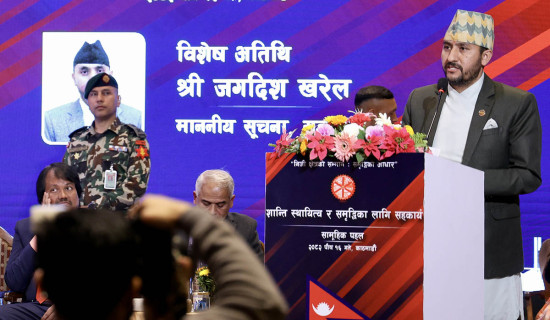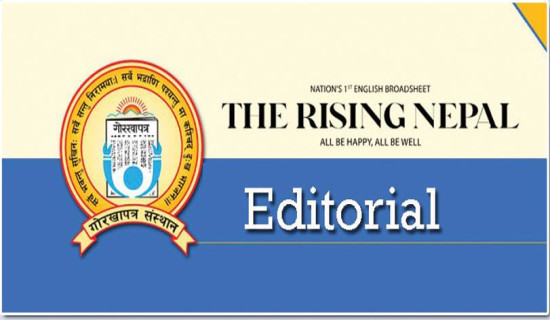- Thursday, 1 January 2026
Solid Sources Fetch News Scoop
In 1989 this week, a union government other than that of the Indian National Congress (then, better known as Congress-I) was installed for the second time since India became independent in 1947. Vishwanath Pratap Singh, routinely described by local media as the “Raja of Manda” in reference to his royal roots, was sworn in as the prime minister by President R. Venkataraman at the hugely impressive Ashok Hall of the presidential palace late in the evening of December 2.
As the leader of Janata Dal, which was the largest constituent of the five-party National Front, Singh headed a coalition government, which obtained “critical support” from outside by Bharatiya Janata Party and Left Front.
This scribe, as The Rising Nepal’s full-time foreign correspondent based in New Delhi, watched and reported with keen professional interest the political events of the 1989-90 period, when India had clamped a harsh economic blockade against the landlocked neighbour. After initialling the trade and transit treaties for a renewed version, India backed out by formally informing Nepal on March 1, 1989 that the previous treaties had expired. Only two of the 15 border crossing points were opened, which created acute shortage of even basic items of daily needs.
Although the single-largest grouping in the fractured Lok Sabha, the Congress sat on the opposition benches, as its leader Rajiv Gandhi could not drum up enough support for the required majority. Virtually all opposition parties had railed against the Congress that met with a drubbing in the three-phase general election held in November 1989.
Congress obtained less than half of the seats at stake, drastically down from the 414 it held in the previous House of 545 members. The opposition had fielded consensus candidates in many constituencies in their one-point programme for ousting the “corrupt and inefficient” Gandhi-led Congress from power. In fact, MPs from the opposition parties all resigned from Lok Sabha to press for fresh elections in the wake of the $ 640 million before bribery scandal involving the Swedish weapons company and the Rajiv Gandhi-led government.
Ill omen
During the election campaign, the National Front’s chief constituent, Janata Dal, projected VP Singh as its prime ministerial face. But when the National Front’s minority government was in clear sight, Chandra Shekhar Singh Solanki created a hitch by staking his own claim to premiership.
Since the National Front had only 143 seats, Chandra Shekhar’s dog-in-the manger policy created an unexpected hitch. He stuck to his position until almost the very end. Haryana leader Devi Lal, too, staked a claim to test the waters for his personal prospects, though he was considered to be the weakest of the trio. Given the election campaign projection, two candidates in the field were too many; and three proved to be a crowd.
History does repeat itself every now and then. In 1979, Charan Singh split Morarji Desai’s Janata Party government — the first non-Congress team at the helm of state affairs — and brought about snap polls. He could not even face a confidence motion in Lok Sabha after the Congress pulled the rug from under his feet. Slightly over a decade later, Chandra Shekhar became a Congress pawn in breaking away from Janata Dal with some 10 per cent of the total number of members in the Lok Sabha in November 1990. With Congress support from outside, he formed a government that predictably fell in less than seven months, after the Congress withdrew support on a transparently flimsy pretext.
Meanwhile, on December 2, 1989, The Rising Nepal carried as its main news my bylined despatch from New Delhi, reporting that VP Singh would be sworn in that day. For the reconfirmation of a major scoop, the largest circulating English daily’s chief editor Shyam Bahadur KC had informed me that that the story would go on the front page in the next day’s edition. I reassured him of the inside development in the National Front camp whose overwhelming majority was for Singh.
No prominent international news media, including BBC, The London Times, The New York Times, The Washington Post and major news agencies like AFP, Reuters, AP and DPA had given any definitive inkling of the development in the making. For that particular news, unimpeachable information sources were required. It so happened that this scribe had cultivated highly resourceful individuals who had very good contacts with some major Indian intelligence agencies and political bigwigs of various stripes.
Sastri Bhawan’s press lounge and canteen, XP (External Publicity) Division’s press room that held daily briefings for journalists, and New Delhi’s posh Connaught Place restaurants had enabled TRN correspondent to build professional rapport with some Indian journalists working for non-Delhi papers or for foreign media.
Drama unfolds
Chandra Shekhar had not given up hope for becoming prime minister. When he agreed to meet a small group of foreign journalists, including me, he made his stand clear and passed disparaging remarks on the VP Singh’s capacity.
Hence, in the crucial afternoon the National Front candidates were to face the MPs at the parliament building’s Central Hall, the suspense was a heart stopping experience. By the time the MPs assembled for electing their leader for premiership, Chandra Shekhar made the first move by proposing Haryana state leader Devi Lal’s name for the high office. VP Singh quickly seconded the proposal.
Amid a sense of shock and immense surprise that spread all over, including the Press Gallery, Devi Lal slowly stood up from his seat and opened his statement of acceptance thanking the two rivals for their kind consideration. In Haryana, he explained, he was affectionately called “tau” or, as he himself translated, “uncle”. He then added that, since he had the mandate of both Shekhar and the Janata Dal President, he would like to hand it over to Singh. To which, the whole assembly burst into elation in approval.
Lal and a not-so-pleased Shekhar exchanged quick handshakes with the prime minister-to-be before Singh left for his residence awaiting the call from the presidential palace to be sworn later that evening. And this exhausted correspondent dashed to the telex room at Sastri Bhawan to file the eventful story to The Rising Nepal.
(Professor Kharel specialises in political communication.)
















